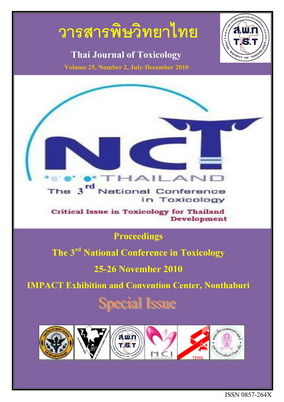Comparative Evaluation of Cadmium Contents in Livestock’s Kidney from Measot District, Tak Province and the SW Vicinity of Bangkok.
Main Article Content
Abstract
Cadmium (Cd), a toxic metal, is considered as an environmental and industrial pollutant. The risk of Cd exposure in non-smoking population is constantly increasing through its contamination via the food chain. In the present study, Cd contents in kidney samples of beef and pig collected from 2 locations: 1) a Cd polluted region of Maesot, Tak and 2) SW vicinity of Bangkok were evaluated. The results revealed that samples from Maesot had broader ranges of Cd levels both in bovine kidneys (geomean: 0.91 ± 0.43 mg/kg, range: 0.19 – 19.60 mg/kg, n=53) and pig kidneys (geomean: 0.73 ± 0.67 mg/kg, range: 0.09 - 40.14 mg/kg, n=112), compared to those from SW vicinity of Bangkok (geomean: 0.14 ± 0.11 mg/kg, range: 0.02 – 2.38 mg/kg, n=27, for bovine kidneys; and geomean: 0.56 ± 0.44 mg/kg, range: 0.01 – 20.21 mg/kg, n=102, for pig kidneys). Based on the maximum limit for Cd in kidney (1 mg/kg), the results also indicated a significantly higher ratio of unsafe beef kidneys from Maesot. Interestingly, although the highest level of Cd detected in pig kidneys from Maesot was twice higher, the percentage of unsafe products was comparable between the 2 locations. As such levels of contamination render these animal products the potential risk to consumer, it is suggested that monitoring of Cd level in livestock organs should be regularly conducted and not be limited to the polluted areas. Consumer education and the routine removal of the high-risk products from the food chain would also help reduce human Cd intake.

